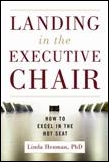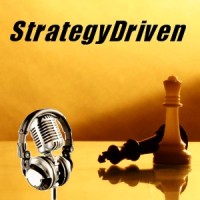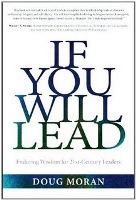Five Ways to Land in the Executive Chair
Executives play in a bigger league; they play for higher stakes; and the game is for keeps. Doing the day-to-day, hands-on work doesn’t fit the job description of the executive; driving the strategy, developing the bench, and making high-caliber decisions have become the new coinage of the realm. When you understand who executives are, what they do, and how they do it, you stand a better chance of joining their ranks.
|
Here are five suggestions for enlisting in this august body of leaders:
- Practice F2 Leader Leadership – What explains the differences between the leader who rises steadily through the ranks versus the one whose career mysteriously jumps the track short of an executive position? If people find the fast track in the first place, they probably know how to get the job done, have displayed integrity, and offer enough intellectual acumen to succeed. When a leader offers all these and still fails, flawed leadership style may be the culprit. F2 Leaders – firm but fair leaders whom others trust – commit themselves to both relationship behavior and task accomplishment.
- Move beyond Problem Solving to Innovative Decision Making – As you climbed the stairs to your current position, others called on you to solve problems. The status quo changed; you figured out the cause for the change; and you returned things to the way they were. But this process only restores the status quo. It doesn’t take the company into the future. Decision making, on the other hand, requires innovative thinking and separates those who land in the executive chair from those who don’t.
- Tie Strategy and Execution Together – A breakthrough product, dazzling service, or cutting-edge technology can put you in the game, but only rock-solid execution of a well-developed strategy can keep you there. Effective execution pushes you to decipher your broad-brush theoretical understanding of the strategy into intimate familiarity with how it will work, who will take charge of it, how long it will take, how much it will cost, and how it will affect the organization overall.
- Plan Succession – The previously perceived quiet crisis of succession is now sounding its siren, and smart companies are responding by creating disciplined approaches to managing their futures. These companies realize replacement planning isn’t enough. These leaders understand you need a systematic approach to talent development.
When people characterize those who land in the executive chair, they often offer ‘vision’ as their most important attribute. Without question, effective leadership requires a strategic focus. But remember. People in mental institutions have visions, too. Seeing into the future is not enough. Those who land in the executive chair and excel there understand they must outrun their competitors, all the while inspiring loyalty among those who follow them.
About the Author

Linda holds a Ph.D. in organizational systems, two Master of Arts degrees in interpersonal communication and organizational development, and a Bachelor of Science degree in communication. By combining her experience as an organizational consultant with her education in business, she offers her clients selection, coaching, and consulting solutions that are pragmatic in their approach and sound in their foundation.


 StrategyDriven Podcasts focus on the tools and techniques executives and managers can use to improve their organization’s alignment and accountability to ultimately achieve superior results. These podcasts elaborate on the best practice and warning flag articles on the StrategyDriven website.
StrategyDriven Podcasts focus on the tools and techniques executives and managers can use to improve their organization’s alignment and accountability to ultimately achieve superior results. These podcasts elaborate on the best practice and warning flag articles on the StrategyDriven website.
 John Maxwell, author of
John Maxwell, author of  Jeff Kortes is known as the ‘No Nonsense Guy.’ He is the President of Human Asset Management LLC, a human resource consulting firm specializing in executive search and leadership training. He has trained hundreds of first-line supervisors, managers, and executives during his career. His approach to training is no-nonsense, and practical.
Jeff Kortes is known as the ‘No Nonsense Guy.’ He is the President of Human Asset Management LLC, a human resource consulting firm specializing in executive search and leadership training. He has trained hundreds of first-line supervisors, managers, and executives during his career. His approach to training is no-nonsense, and practical. Michael Feuer cofounded OfficeMax in 1988 starting with one store and $20,000 of his own money, a partner, and a small group of investors. As CEO, he grew it to more than 1,000 stores worldwide with annual sales topping $5 billion. He is also CEO of Max-Ventures, a venture capital and retail consulting firm, and founder and CEO of Max-Wellness, a comprehensive health and wellness retail chain that launched in 2010. After opening initial laboratory test stores in Florida and Ohio, a national roll-out is now underway. To read Michael Feuer’s complete biography,
Michael Feuer cofounded OfficeMax in 1988 starting with one store and $20,000 of his own money, a partner, and a small group of investors. As CEO, he grew it to more than 1,000 stores worldwide with annual sales topping $5 billion. He is also CEO of Max-Ventures, a venture capital and retail consulting firm, and founder and CEO of Max-Wellness, a comprehensive health and wellness retail chain that launched in 2010. After opening initial laboratory test stores in Florida and Ohio, a national roll-out is now underway. To read Michael Feuer’s complete biography,  Dustin S. Klein, contributor and editor of The Benevolent Dictator, is the publisher and executive editor of Smart Business Network, publishers of Smart Business, the nation’s second-largest chain of regional business publications. He has interviewed thousands of senior executives and civic leaders across America. He is a regular presenter on business-related issues for public and private business audiences and is a frequent guest on television, radio, and Internet programs. To read Dustin Klein’s complete biography,
Dustin S. Klein, contributor and editor of The Benevolent Dictator, is the publisher and executive editor of Smart Business Network, publishers of Smart Business, the nation’s second-largest chain of regional business publications. He has interviewed thousands of senior executives and civic leaders across America. He is a regular presenter on business-related issues for public and private business audiences and is a frequent guest on television, radio, and Internet programs. To read Dustin Klein’s complete biography, 
 Doug Moran, author of
Doug Moran, author of